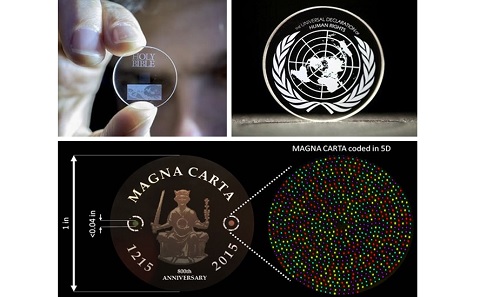5D memory – the Superman memory crystal
Researchers at the University of Southampton have developed a breakthrough method of fusing nanostructures in quartz glass using ultrashort laser pulses. In addition to the 3D coordinates of the resulting nanopores, the dual refractive properties of the glass allow the control of two parameters – slow axis orientation and retardance. This resulted in 5D Memory: a virtually everlasting, indestructible storage technology allowing hundreds of terabytes of data per memory crystal.

Research challenge and context
The demand for long-term data storage is reaching unprecedented levels. By 2025, the world will store 200 zettabytes (2x1023 bytes), with half of this on the cloud (2020 Data Attack Surface Report). Operating at such scales requires a fundamental re-think of how we build large-scale storage systems and their underlying technologies.
Our solution
The concept behind this research is the bulk storing of data optically in quartz glass, which is renowned for its high chemical and thermal stability and resistance, and accordingly is notoriously difficult to etch without cracking. Researchers at the University of Southampton were the first to pulse laser quickly enough to encode data in the glass, demonstrating recording and retrieval of digital documents with a nearly unlimited lifetime.
What was the impact?
The huge implications of the technology for long-term data storage were immediately recognised by industry, and in October 2016 Microsoft set up Project Silica to translate it into “the first-ever storage technology designed and built from the media up, for the cloud”. Popularly known as the Superman memory crystal, 5D Memory forms the basis of a collaboration with Warner Bros for the long-term storage of films, with resilience at room temperature being a key factor.
The mind-boggling capability of the technology, in combination with its striking elegance, have captured the fascination of the global creative sectors, cultural heritage industries and the media. Its high-profile applications have included a Magna Carta presented to Salisbury Cathedral, a Bible presented to the Vatican Library, and Isaac Asimov’s Foundation Trilogy stored in the glovebox of Elon Musk’s Tesla Roadster on board Falcon Heavy during its successful test launch.
Related pages
Eternal 5D data storage could record the history of humankind